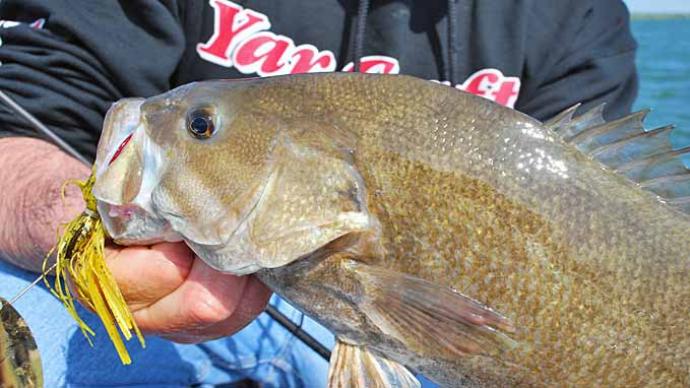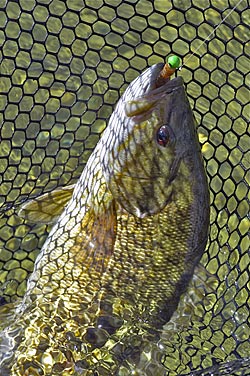
Waugoshance Point has been on my bucket list for a long time. The area has been famous for its smallmouth bass fishing since the 1960s but declined in the 1970s when overfishing took its toll. Fishing has rebounded dramatically in recent years. Changes in anglers’ attitudes and changes in the Great Lakes have returned Waugoshance Point to the smallmouth Mecca it once was.
Waugoshance Point is a myriad of shoals in Michigan's northwest Emmet County that extends from Wilderness State Park. The shoals are evidence of the glaciers that descended on the area some 12,000 years ago, and the rubble left behind. The rocky substrate extending from Waugoshance Point is a haven for smallmouth bass. Still, the reef, along with others in the vicinity, is an exceptionally dangerous hazard for sailing vessels and small craft along the northeastern rim of Lake Michigan.
Waugoshance is derived from the Anishinaabemowin word wah’goosh and the French word anse, which means cove.
A graduate student, Emily Kristen Martin, found, “The smallmouth bass population at Waugoshance Point has increased, and individual smallmouth bass are larger, have a better condition, and grew faster in juvenile stages in recent years relative to the 1950s.” A similar increase in bass numbers has been observed in the adjacent Beaver Island Archipelago.
Waugoshance Point has always had exceptional smallmouth habitat, but recent changes have revitalized the fishery. Bass grow very slowly in the cold, clear water of Lake Michigan. A 15- or 16-inch bass is likely ten years old or older. Removing that fish from the population takes a long time to replace. The large bass are also generally females. Fortunately, the horror stories of anglers taking coolers full of bass off their spawning beds are ancient history.
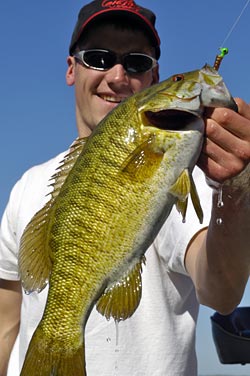
What has helped Waugoshance Point smallmouths the most is catch and release. Most anglers these days practice it. Attitudes about keeping bass have altered dramatically since the 1970s, and Waugoshance’s bass have benefited and responded. The change results from bass fishing exposure on TV, tournaments, changing attitudes, and the fact that anglers are not consumptive orientated anymore.
You do not hear about anglers keeping limits of bass anymore, and the fishery shows it. Studies reveal that “Increased growth rates and high relative weights indicate that smallmouth bass at Waugoshance Point are not experiencing high natural mortality. Increased abundances and greater length-at-age in the recent period indicate a population with low natural mortality.” This trend is mainly thanks to anglers. Higher minimum size limits have also helped.
Another reason why Waugoshance bass are prospering is because of the changes that have occurred in Lake Michigan. Lake Michigan is clearer than it has ever been. That is primarily due to the infestation of invasive zebra mussels in the 1990s. Zebra mussels live by filtering algae from the water column. By filtering algae from the water column, zebra mussels reduce the primary food source for some species, like zooplankton, while increasing the amount of light that reaches plants used as fish habitat on the bottom.
Zebra mussels fix or transfer energy from higher in the water column to the lower levels, called benthification. By doing so, zebra mussels redirect vital energy to support aquatic life on the lake bottom. Clearer water also benefits sight-feeders, like smallmouths. “However, the effects of zebra mussels on fish are not wholly negative,” claimed Andrea Miehls of the Great Lakes Fishery Commission. “Our models suggest that other fishery species benefit in some ways from zebra mussels.” Smallmouth bass are one of them.
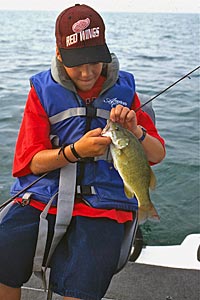
Waugoshance smallmouths also benefit from the change in substrate or lake bottom attributed to zebra mussels. Smallmouth bass cannot spawn successfully on a smooth rock or sand bottom. Once zebra mussels colonize the rocks, the mussels themselves provide a substrate bass can spawn on. The interstitial space between them produces crevasses that smallmouth eggs can nestle into and be protected from predators. Now that zebra mussels have colonized the habitat; bass spawning success has dramatically improved.
Other invasive species have benefited Waugoshance bass, too. Round gobies have provided a reliable food source that has helped smallmouth bass thrive. Martin found, “Increased growth at a younger age due to predation on round goby may also contribute to increased length-at-age and a higher proportion of large smallmouth bass. The increase in age one growth increments for smallmouth bass may result from the availability of round goby as a prey source, and the abundant prey source may also aid their transition to piscivory.” Zebra mussels may be responsible for higher bass spawning success, and round gobies help young bass grow faster during their early life stages.
While adult bass at Waugoshance Point eat gobies like candy, they also gobble up another invasive specie-the rusty crayfish. Native to the Ohio River Valley, rusty crayfish is one of four crayfish species native to the Great Lakes region. Likely introduced via someone’s bait bucket, rusty crayfish are voracious feeders and feast on aquatic plants, invertebrates, insects, detritus, fish eggs, small fish, and other crustaceans. So far, their impact has not been quantified, except that smallmouth love them. With two more forge species to prey on, the trend for more catch and release, and better spawning conditions, it’s easy to see why Waugoshance bass are thriving again.
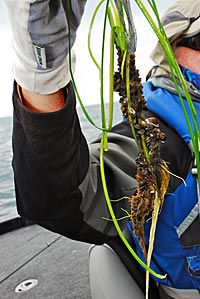
There is evidence that Waugoshance Point, the Beaver Island Archipelago, the northern shore of Lake Michigan, and even the northern shore of Lake Huron may share some of the same bass. The bass from Beaver Island have been caught at Waugoshance Point, but it appears to be a one-way trip.
Wilderness State Park is an ideal base of operations for anglers looking to sample Waugoshance’s surreal smallmouth fishing. Wilderness State Park has modern and semi-modern campsites and cabins. There is a boat launch and harbor at the park adjacent to Waugoshance Point. For more information, go to https://www2.dnr.state.mi.us/parksandtrails/ or call 231-436-5381.
Northern Lake Michigan is slow to warm, and the bass spawn usually doesn’t occur until sometime between mid-June and mid-July. Bass can be caught at Waugoshance all summer long, though. Some of the best fishing might be during the post-spawn when bass are putting on the feedbag. Look for the bigger bass forging on some outer shoals, such as New Shoal #1, #2 and #3, Rose Shoal, and Grays Reef in deeper water. The reefs and shoals extend 15 miles or more into Lake Michigan toward Beaver Island.
The most crucial tool for anglers fishing Waugoshance Point is a pair of good polarized sunglasses. The glasses are needed to spot spawning bass, rocks, and boulders where the bass may be hiding. Pay particular attention to the shadows of boulders during midday.
Anglers can wade, kick around in a float tube or use a boat, but do all three with caution. Keep an eye on the weather. Waugoshance Point is very exposed, and weather systems can move quickly.

Back in the ’50s and ’60s, when bass fishing was just being discovered at Waugoshance Point, there was no such thing as drop-shotting. The technique is deadly on Waugoshance bass. Hopping a tube along the bottom, searching with a white spinnerbait, or twitching a stick bait on a calm morning can also be a hoot for bass that will average 2- to 3-pounds. 5-pound brutes are not unheard of these days. Use spinning gear and 4- to 8-pound fluorocarbon or clear mono in the crystalline waters.
Waugoshance Point is a prime example of what a change in angler attitudes and a habitat transformation can do to revitalize a fishery.


